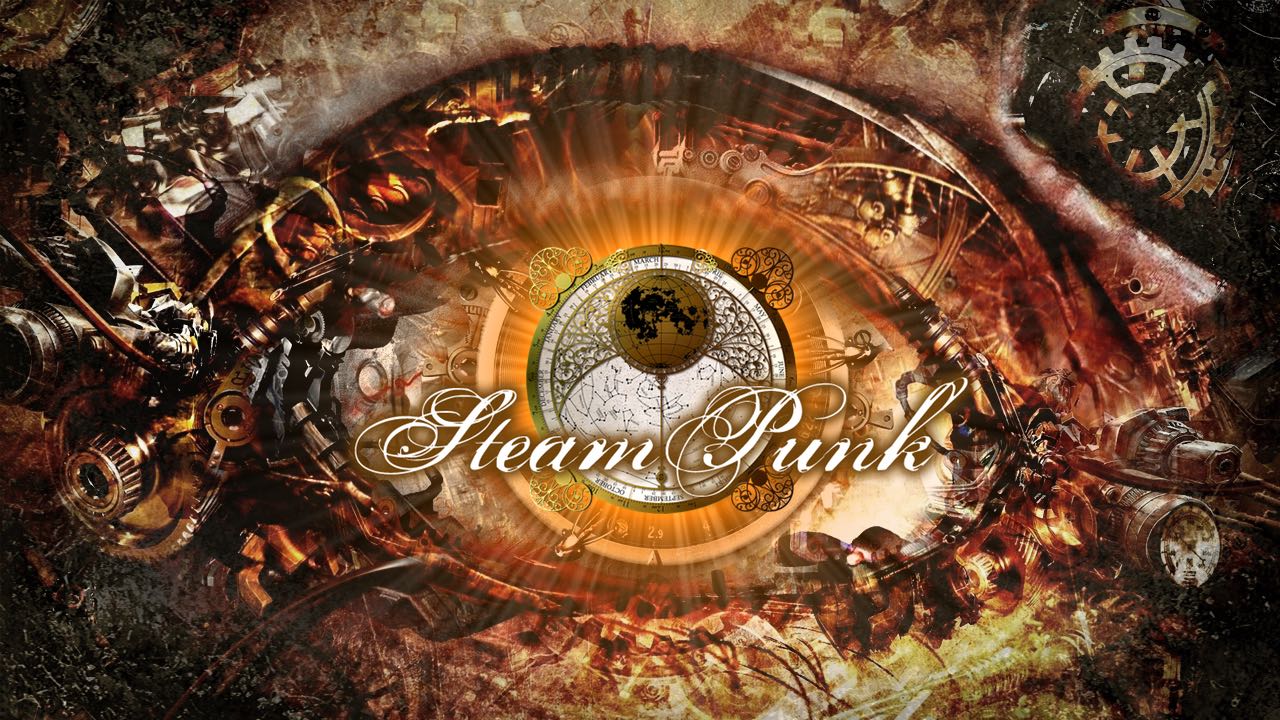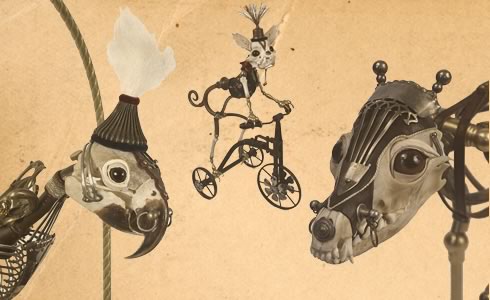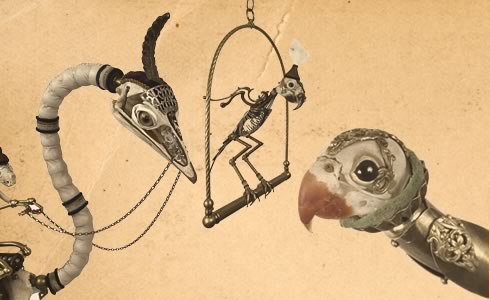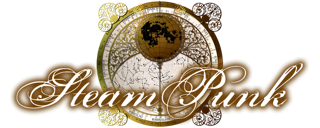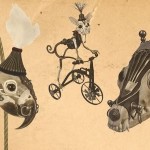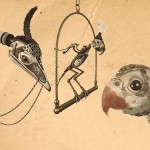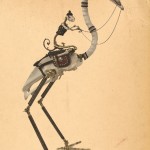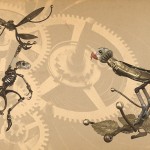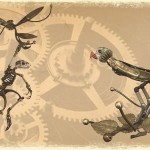Jessica Joslin, em suas próprias palavras, é uma artista que constrói peças que podem ser descritas como Animais Mecânicos Vitorianos SteamPunk.
Em seu discurso coeso acerca da natureza de sua obra, Jessica Joslin nos deixa passear pelo seu conceito de arte e pelo valor que dá a criatividade e a expressão.
As peças que confecciona vem sendo exibidas em galerias e despertando o interesse de público e crítica o que, para o SteamPunk, é particularmente importante.
Artistas como Jessica Joslin são a linha de frente da popularização da estética SteamPunk, que é a porta de entrada de muitas pessoas para o gênero que, cada vez mais, se define como muito mais que só um “jeito da coisa se parecer”.
Conselho SteamPunk: É nossa opinião que grande parte do seu trabalho se fundamenta na forma subversiva que você captura a vida. Você concorda ou acha que estamos totalmente enganados?
Suponho que meu trabalho possa ser considerado subversivo em certo sentido sim, mas não tento chocar ninguém. Creio que há uma marginalidade inerente no fato de que estou representando a criatura viva com material inanimado, inclusive restos de esqueletos. Usar ossos para representar vida pode sim ser considerado subversivo, mas não é esta minha intenção.
Conselho SteamPunk: É comum que algumas pessoas se sintam ofendidas por esta forma de expressão? Seu apreço pelos animais já foi questionado pelo público?
Ocasionalmente, mas não é tão comum. Talvez surpreendentemente, tenho percebido respostas genuinamente interessadas das pessoas com quem tenho contato sobre meu trabalho, incluindo aquelas envolvidas em direitos dos animais. Tenho grande afinidade com os animais e creio que isso se percebe em meu trabalho. Uma coisa é certa; Tudo que é vivo morre. Eu apenas coleto o que fica para trás…
Para obter os ossos que utilizo, trabalho com fornecedores osteológicos. Tratam-se de profissionais especialistas que fornecem para museus, escolas e instituições de pesquisa. Sou muito consciente das implicações éticas e ambientas do trabalho com ossos de animais e sou cautelosa em trabalhar com empresas cujas práticas estejam acima de qualquer reprovação.
Conselho SteamPunk: Seu trabalho com protótipos de brinquedos e modelos influenciaram sua arte?
Sim, foi através deste trabalho que adquiri muitas das habilidades necessárias para confeccionar minhas peças. Precisão é algo importante para mim, bem como a beleza das peças. Foram necessários 20 anos de treino nas mais diversas disciplinas. Todas elas se manifestam em meu trabalho, concorrendo para melhorá-lo e enriquecê-lo. Creio que é como tudo mais… quanto melhor você se torna em algo, mais fácil lhe parece. De um ponto de vista estrutural, muitos sequer se dão conta da complexidade e precisão do meu trabalho. Por exemplo um único pé de Ludwig – “The Monkey on the Ball” – é composto de 30 partes individuais, todas unidas e bem montadas. Há muita engenharia (e requinte) em cada peça que parece ter sido feita sem grande dificuldade, como se elas fossem destinadas a ter aquela forma.
Conselho SteamPunk: Você vem colecionando há muitos anos partes de animais e antigos componentes mecânicos. Esta prática tem alguma relação com um desejo implícito de consertar a vida quando esta se encontra “quebrada”?
Esta pergunta é interessante. A resposta tem relação, parcialmente, com onde eu estudei e com o lugar onde cresci. Minha infância e adolescência se deu em Boston, e desde muito cedo senti-me arrebatada pela maravilha que eram os museus da Universidade de Harvard, particularmente o Museu de Zoologia Comparada. Haviam galerias e mais galerias cheias de taxidermia da Era Vitoriana, que eram particularmente fascinantes. Anos depois fui estudar em Chicago e, a caminho dos estudos, passava por um edifício de vidro espelhado que tinha uma grande fonte diante da fachada. Os pássaros que por ali voavam continuamente batiam de encontro ao vido e caiam nas águas da fonte, com os pescoços quebrados.
Todos os dias eu via estes pássaros preciosos flutuando naquelas águas até que os zeladores apareciam, recolhiam-nos sem cerimonia em suas redes e os jogavam no lixo, o que me deixava triste. Não parecia correto que aquelas criaturas adoráveis morressem sem qualquer propósito e então fossem atiradas ao lixo. Decidi, em certo ponto, que revisitaria minha fascinação pela taxidermia. Comecei a estudar como preservar as aves, lendo livros sobre o assunto e, ao invés de somente passar pela fonte, eu retirava minhas botas e coletava as aves mortas (muitas vezes para horror daqueles que assistiam!) para então usá-las para praticar taxidermia.
Desta forma acumulei uma coleção respeitável de aves empalhadas, que acabei por incorporar mais tarde em meu trabalho. Suponho que até os dias de hoje o meu uso de ossos vem do desejo de celebrar a beleza dos animais, vivos ou não. Este sentimento vem parcialmente de colecionar coisas que, de outra forma, seriam esquecidas ou subestimadas.
Conselho SteamPunk: Você conhece o gênero SteamPunk? Considera seu trabalho uma referência do gênero?
Sim. Há alguns trabalhos muito interessantes sendo feitos dentro do gênero. Latão é um material que me agrada muito e sou apaixonada pela Era Vitoriana, portanto posso dizer que definitivamente meu trabalho bebe nesta mesma fonte.
Conselho SteamPunk: A recente popularidade do gênero SteamPunk afetou o interesse pelo seu trabalho?
O SteamPunk ofereceu mais um meio de divulgar e apresentar o meu trabalho para pessoas cuja sensibilidade estética é similar a minha. Sob este aspecto certamente ajudou. Entretanto, como todo movimento de contra-cultura que atinge certo grau de popularidade, há um efeito colateral inevitável. Parece que, agora que o movimento ganhou notoriedade, para cada grupo de pessoas que amam o SteamPunk há aqueles que dele se afastaram pelo mesmo motivo.
De muitas formas a característica “faça-você-mesmo” do SteamPunk foi o maior benefício e o maior problema do movimento, particularmente no que se refere aos artistas. É maravilhoso que algo tenha surgido para inspirar artistas iniciantes a colocar para fora suas habilidades e seu talento. Jamais teremos artistas suficientes no mundo! No entanto, por conta da mesma mentalidade “faça-você-mesmo”, o movimento vem sendo assombrado por questões relacionadas a apropriação e plágio.
Por conta da familiaridade com tutoriais online (como instruções passo-a-passo para modificar um teclado de computador para que se pareça com uma máquina de escrever antiga), alguns acabaram por acreditar que a apropriação de qualquer idéia é eticamente aceitável.
Recebo cartas de pessoas que dizem desejar confeccionar sua própria versão do meu trabalho, perguntando onde podem conseguir os elementos para tanto e como deveriam proceder. Estas pessoas não parecem entender o quanto isto é inadequado. É uma visão totalmente equivocada do meu trabalho. Sim, qualquer um pode conseguir um crânio e atar a isso um pedaço de latão, mas isto não capturaria o espírito da minha obra ou aquilo que luto para alcançar… qualquer tentativa diletante vai se parecer com o que é… uma cópia barata. Muito compreendem isso, mas não todo mundo.
Uma das coisas que mais amo no SteamPunk é justamente a atenção aos detalhes. Para cada pessoa que, equivocada, pensa que um par de “googles” junto a acessórios de latão são sinônimo de SteamPunk, há muitos outros que se esforçam para alcançar outro patamar de refinamento e minúcia. Em minha opinião trata-se de um senso de entendimento da conjuntura sociológica, tecnológica e cultural da Era das Máquinas que garante a riqueza e profundidade ao movimento.
Tratava-se de um momento histórico no qual os objetos não eram descartáveis. As pessoas gastavam muitos anos aprendendo um ofício específico e refinando sua habilidade. Quando se construía algo (fosse uma obra de arte, vestuário, móveis ou máquinas) havia o cuidado em se tentar fazê-lo da melhor forma possível. Não havia atalhos. Havia um magnífico senso de respeito por tudo aquilo que era conseguido através de sacrifício. Em nosso tempo, muitos artistas iniciantes sentem a necessidade de buscar o sucesso antes de terem tido tempo de alcançar uma visão própria e única da arte. Eles buscam a aprovação antes mesmo de desejá-la. Eu acredito firmemente que isto nos empobrece a todos. É necessário muito tempo para se criar algo especial e original… não são estas algumas das virtudes que melhor definem a arte?
Conselho SteamPunk: Você aprovaria e participaria de uma Liga de Artífices SteamPunk? Acha importante partilhar experiências com artistas de diferentes países e segmentos?
A sensibilidade para apreciar e entender o ofício do artesão é algo pelo que tenho muito apreço. Despendi muito tempo trabalhando com diferentes técnicas para refinar minhas habilidades. De fato creio que a maior parte (senão todos) os artistas se beneficiariam da exposição a outras técnicas, fazendo o bom e velho trabalho manual. É um belo teste para o engajamento e dedicação do artista!
Certamente endosso uma Liga de Artífices, caso os padrões elevados da Era Vitoriana fossem a meta de seus participantes. É preciso ter cuidado, contudo, pois eu mesma sou bastante intransigente com detalhes. Tinta spray dourada não passa por latão, em hipótese alguma. Quem discorda deveria ser açoitado com uma luva de couro! ; )
Isto posto, muitos artistas se benefeciariam grandemente do intercâmbio com outros profissionais, inclusive eu. Eu sempre aprecio o contato com outros artistas e artesãos cujos interesses são similares aos meus.
Conselho SteamPunk: Como o grande público pode adquirir seu trabalho e seu livro?
Recentemente houve uma exposição minha no Billy Shire Gallery. Os trabalhos disponíveis em:
http://billyshirefinearts.com/08joslin/index.html
Sou agenciada pela Lisa Sette Gallery e alguns outros trabalhos estão disponíveis em seu website:
http://billyshirefinearts.com/08joslin/index.html
Meu livro, “Strange Nature”, pode ser aquirido em:
http://shop.psstudios.com/index.php/products/joslinbook
E mais informações sobre o livro podem ser encontradas aqui:
http://www.lisasettegallery.com/books.htm
Perguntas sobre Arte (continuar lendo…)
Conselho SteamPunk: Temos algumas perguntas sobre suas influências artísticas, sobretudo para nossos leitores ligados a arte.
Conselho SteamPunk: De que modo Albertos Seba e Walton Ford influenciaram seu trabalho?
Em ambos os casos tenho grande respeito por sua graciosidade, estilo fluído e refinamento. A obra de Albertus Seba, tem um senso de distinção entre sua obra e a ciência. Seba (1665-1736) viveu numa época em que as maravilhas de outros continentes ainda representavam um mistério. Muitos dos animais que retratou ele jamais havia visto antes. Muitos artistas/naturalistas da época, quando lidavam com animais exóticos, trabalhavam em cima dos esboços de outros artistas ou a partir de espécimes preservados. Em muitos casos, o animal retratado era discrepante da realidade por conta de mitos, falsos conceitos ou até por conta dos efeitos imprevisíveis da preservação. Por conta disso, havia uma disparidade muito grande entre o animal real e aquele que fora imaginado. Acaba que o produto final eram os animais que conhecemos, mas com um toque de mito, por conta de terem sido involuntariamente modificados. Há uma poesia magnífica no resultado final, que ficam em algum lugar entre uma quimera e aquilo que nos é familiar.
O trabalho de Walton Ford é muito influenciado por John James Audubon e por seus conteporâneos colegas, tenham eles sido artistas, naturalistas, caçadores ou exploradores. Sempre fui fascinada pelas imagens líricas de Ford, mas também pelas histórias por detrás delas. Ele invoca a ironia da Era Vitoriana e Pré-Vitoriana, quando naturalistas coletavam avidamente espécimes para seus museus e escrivaninhas de curiosidades. A atitude cultural da época podia ser descrita como “Matemo-los para olharmos para eles”. Ford dá um jeito de lidar com estas questões com um humor sutil nada didático. As linhas fluídas de criaturas graciosas me inspiram a criar esculturas em poses estilizadas nas quais jamais pensaria se não tivesse sido influenciada por ele.
Conselho SteamPunk: A obra de Catherine Chalmers também é fonte de pesquisa para você? Como os dioramas e desenhos de Frederik Ruysch afetaram seu trabalho?
Nunca tive o prazer de ver seus trabalhos pessoalmente, mas os conheço principalmente através do trabalho de Cornelius Huyberts. No que se refere a mistura de materiais, contudo, creio que ele é um dos mais fascinantes. Ele coloca arte e ciência numa sintonia que constantemente me intriga.
Ruysch online: http://www.zymoglyphic.org/exhibits/ruysch.html
Conselho SteamPunk: Eugen Von Bruenchenhein, Pierre et Gilles e Matthew Barney têm um estilo sensualmente grotesco e quase surrealista. Qual o impacto disto em sua arte?
Esta é uma pergunta difícil, porque estes três artistas tem muito pouco em comum. Talvez o que haja em comum entre eles seja a extravagância recorrente, a decadência detalhista e uma abordagem cinemática ao retratar seu entorno. Embora eu não possa alegar um impacto direto em meu trabalho, os artistas cujo trabalho eu aprecio acabam tendo sua influencia manifestada de formas inesperadas. Tanto Pierre et Gilles quanto Mathew Barney usam cores de forma extraordinária… Há um sendo de conformidade nelas… pompa e circunstância. Seu uso de uniformes é, provavelmente o que mais se manifesta em meu trabalho pois, embora eu trabalhe a forma animal, alguns detalhes decorativos como colares, algemas e chapéus acabam sendo utilizados.
Os retratos de Von Bruenchenhein de usa esposa talvez seja o que mais o aproxima dos outros dois artistas, mas seu trabalho mais influente, para mim, foram suas “torres de ossos”. Ele era um artesão sem treinamento formal, um artista marginal, sem muitos recursos, que vivia no meio oeste. Através dos anos ele colecionou ossos de galinhas do jantar e os transformou em intrincadas torres de ossos, reminescentes das Torres de Watts, e pequenos tronos, que pintou em cores brilhantes. Quando me mudei para Chicago tive a oportunidade de ver uma mostra de seu trabalho e fiquei fascinada pelo detalhismo e beleza de seu trabalho. Eu já começara a construir obras com mistura de materiais, que incorporava ossos, mas este foi um dos poucos artistas, na época, que trabalhavam com material similar.
Conselho SteamPunk: Quando você menciona ter sido influenciada pro P.T.Barnum você sugere que ele seja de fato um artista? É incomum que se pense nele desta forma. Discorda do senso comum neste particular?
Barnum provavelmente jamais se considerou um artista (apesar de certamente jamais ter tido problema algum de auto-confiança). Acima de tudo considerava a si mesmo como um Showman. Pessoalmente o considero sim um artista, ainda que de uma forma que jamais foi reconhecida como arte até muito recentemente. Ele era mestre na manipulação do público e da media, um verdadeiro mestre do espetáculo. Barnum foi o responsável pela Sereia de Fiji, tida como um dos mais famosos embustes já encenados. Além de seu circo intinerante, ele fundou o American Museum (1841-1865) onde exibia as maravilhas da tecnologia, como automatos, junto de pinturas clássicas, mostras de história natural e figuras em cera.
Mais sobre o American Museum, de Barnum, pode ser encontrado em:
http://www.lostmuseum.cuny.edu/home.html
Conselho SteamPunk: Sua afinidade com Giuseppe Arcimboldo é responsável por sua caracteristica de olhar para além da forma original da criatura entorno da qual você esculpe?
O que mais amo em seu trabalho, para além da beleza formal, é que este funciona ao mesmo tempo em diferentes níveis perceptivos. Primeiro você vê a imagem geral, depois começa a perceber os elementos díspares que se combina para criar a ilusão da figura inicialmente percebida. De alguma forma, ele cria um senso de homogeneidade no lugar do caos.
Conselho SteamPunk: A estranheza e fascínio exercido pela arte de Lee Bontecou parece sempre presente em suas esculturas. Em que você entende que ela influenciou em sua arte?
Só recentemente conheci o trabalho de Bontecou, mas fiquei imediatamente abismada com o quanto temos em comum. Ela é claramente uma apaixonada pelo mundo natural, bem como é uma mestra do uso de múltiplos materiais. A representação dos animais e de seus ossos aparecem em muitos de seus trabalhos mais recentes. Seus mobiles e outras construções esculturais igualmente incorporam uma miríade de materiais e reconheço sensibilidade, brilhantismo e uma capacidade incrível para reinterpretar as formas naturais.
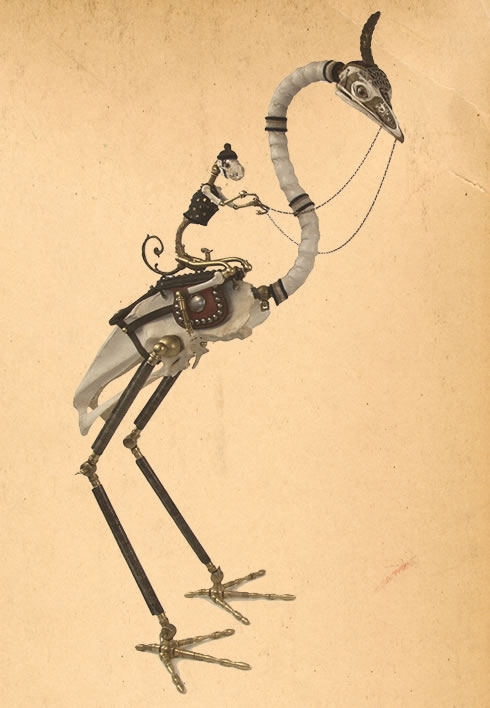
Jessica Joslin Interview in English
Conselho SteamPunk: Could you please start by saying “Who is Jessica Joslin?”
I am an artist who builds things that might be described as Victorian Steampunk Mechanical Animals.
Conselho SteamPunk: In our opinion a great quality and beauty of your sculpture resides, in part, at its subversive way of capturing the living form. Do you agree or we’re totally misleaded?
I suppose my work could be considered subversive on certain levels, but I am certainly not looking for shock value. I think that there is an inherent disconnect in that I am representing a living creature with inanimate materials, some of which are skeletal remains. I suppose that using bones to represent life could be considered subversive, but that isn’t my primary intent.
Conselho SteamPunk: Was there any offensive comments on your work? Have people get offended over one of your sculptures? Has your fondness of animals ever being questioned while you got in contact with the public?
Occasionally, but not often. Perhaps surprisingly, I have generally received interested, supportive responses from the people who I’ve spoken with, including those who are involved in animal rights organizations. I have a very strong affinity for animals, and I think that comes across in my work.
One thing is certain; all living things will die. I merely collect what is left behind. For obtaining the bones that I use, I work with professional osteological suppliers. These are specialists who supply bone specimens to museums, schools and research institutions. I am very much aware of the ethical and environmental implications of working with animal bones and I take care to work with companies whose policies are above reproach.
Conselho SteamPunk: Does your work with toy prototypes and models influence your art?
Yes, it’s through my professional work that I’ve acquired the many skills needed to build my pieces. Precision is important to me, as is beautiful craftsmanship. I’ve spent 20 years training in various disciplines. All of these translate back into my own artwork, helping to improve and enrich it. I suppose it’s like anything, the better that you get at something, the easier it looks. From a structural standpoint, many people don’t realize the complexity and precision of my work. For example, just one foot on Ludwig (the monkey on the ball) is comprised of 30 separate parts, all of them tapped and threaded. There is a lot of engineering (and finesse) that goes into making them seem natural and effortless, as if they were meant to be.
Conselho SteamPunk: You have being collecting animal parts and antique mechanical parts. Is this practice in any way related to a inner desire to fix “broken life”?
That’s an interesting question. The answer is partly related to where I went to school and partly related to where I grew up. I grew up in Boston and from a very early age, was struck by the marvelous museums at Harvard University, particularly the Museum of Comparative Zoology. There were rooms upon rooms filled with Victorian era taxidermy, these in particular always fascinated me. Many years later, I went to college in Chicago. On my way to class, I would walk past a tall, mirrored glass building, with a large fountain at its base. As often happens with mirrored buildings, birds would fly into it and would fall into the fountain, with their necks broken. Every day, I would see all of these jewel-like birds floating in the water, then the maintenance crew would appear, sweep them up in nets and throw them in the trash. That made me sad. It didn’t seem right for these lovely little creatures to die so unnecessarily and then be put out as garbage. I decided then that I would revisit my childhood fascination for taxidermy. I set about teaching myself to preserve the birds, using books from the library. Instead of walking past the fountain, I would pull off my boots and wade in to collect the dead birds (often to the horror of onlookers!) Then use the birds to practice taxidermy on. In this way, I accumulated quite a collection of taxidermy, which I later began to incorporate into my artwork. I suppose that to this day, my use of bones stems from a desire to celebrate the beauty of animals, whether living or not. That feeling partly stemmed from collecting things that might otherwise be overlooked or undervalued.
Conselho SteamPunk: Are you aware of the SteamPunk genre and do you consider your work related to it?
Yes. I think that there is some very interesting work being done in that genre. Brass makes me very happy and I am quite enamored of the Victorian era, so I would say that there is definitely common ground.
Conselho SteamPunk: Have the recent popularity of SteamPunk affected the interest on your work? How do you like and how much you know of the SteamPunk culture/movement/genre?
It’s offered another means of getting my work out there, to people whose visual sensibilities are similar to my own. In that way it’s certainly helped. However, with any underground movement that achieves mainstream popularity, there is an inevitable backlash. It now seems that for as many people as love Steampunk, there are people who have turned away from it as it gains in notoriety.
In many ways, the DIY ethos of Steampunk has been the greatest benefit, as well as the biggest problem with the movement, particularly as it relates to artists. It’s wonderful that something has come along to inspire young artists to hone their abilities and craft. There is not nearly enough of that! However, because of that same DIY mindset, the movement has been beset with issues related to appropriation and plagiarism. Because of a familiarity with online tutorials (for example, step-by-step instructions to modify a computer keyboard to look like an antique typewriter) some have come to see anything as fair game for appropriation. I have gotten letters from people saying that they want to build their own version of my work, where can they get the parts and how should they proceed? They don’t seem to understand why that is inappropriate. It misses the point of my work entirely. Yes, anyone can get a skull and stick a piece of brass on it, but that wouldn’t capture the spirit of my work or what I strive to achieve…it just looks like what it is, a cheap copy. I do think that most people get that, but certainly not all.
One of the things that I love most about Steampunk is the attention to details. For every person who misguidedly thinks that a pair of goggles+some old brass collectibles=Steampunk, there are many more who strive for refinement in minutiae. For me, it is a sense of understanding the sociological, technological and cultural conditions of the Machine Age that brings a richness and depth to the movement. It was an era when objects were not disposable. People spent many years learning a specific trade and honing their skills. When they made something (whether artwork, clothing, furniture or machinery) they made certain that it was absolutely the best that it could be. They didn’t cut corners. There was a wonderful sense of respect for hard-earned accomplishment. In our times, too many young artists feel the need to seek success before they have put in the time to refine their own vision. They seek validation before they are deserving of it. I feel like that impoverishes us all. It takes time to make something special, something original…aren’t those the qualities that best define art?
Conselho SteamPunk: Would you endorse and/or join a SteamPunk League of Craftsmen (/CraftsWomen) =) ? Do you think it is important to share experiences with artists from different countries?
A sense of understanding and appreciating fine craftsmanship is something that I feel very strongly about. I’ve spent a great deal of time working in various trades to refine my skills. Actually, I think that most (if not all) artists would benefit from spending some time in the professional trades, doing some good old-fashioned manual labor. It’s a very good test of your mettle and dedication!
I would certainly endorse a league of Craftspeople if its standards were held to a Victorian-era level of refinement! I must warn you though, I’m a stickler for details…gold spray paint doesn’t pass for brass, no matter what. Anyone who disagrees should be bitch-slapped with a kid leather glove! 😉
That said, most artists benefit greatly from learning from others in their field, myself included. I always enjoy hearing from other artists and craftspeople whose interests are similar to my own.
Conselho SteamPunk: How can the public acquire your work and book?
I currently have a show of my work at Billy Shire Gallery. Available works are posted online: http://billyshirefinearts.com/08joslin/index.html
I am represented by Lisa Sette Gallery, additional works are on their website. http://www.lisasettegallery.com/a-joslin.htm
My book, Strange Nature, can be purchased here: http://shop.psstudios.com/index.php/products/joslinbook
And more information on the book can be found here:
http://www.lisasettegallery.com/books.htm
About your influences a couple of questions should enlighten our audience on your art.
If you feel it is not necessary to talk about some of these artists feel free not to answer the question.
Conselho SteamPunk: In what way would you say Albertus Seba and Walton Ford influenced your work, being him an exceptional engraver of animals?
In both artists work, I have a great respect for their graceful, fluid style and technical refinement. In terms of Albertus Seba’s work, there is also a wonderful sense of disconnect between the artistic aspects of the work and the scientific. Seba (1665-1736) lived during an era when the wonders of far away lands were still mysterious. Many of the animals that he depicted were ones that he had never seen before. Most artist/nauralists from the time, when dealing with exotic animals, worked either from other artists’ sketches, or from preserved specimens. In many cases, the depicted animal was distorted by myths and misconceptions, or physically, from the unpredictable effects of preservation. Because of this, there was a wonderful discrepancy between the real animal and the imagined one. One ends up with animals that are known to us, but have the flavor of mythical beings because they had been (unintentionally) modified. There is a marvelous poetry to the final product, half way between a chimera and the familiar.
Walton Ford’s work is very much influenced by John James Audubon and his artist/naturalist/hunter/explorer contemporaries. I have long been enraptured by Ford’s lyrical images, but I am equally fascinated by the stories behind them. He touches on the many ironies inherent in the Victorian and pre-Victorian periods, when naturalists were avidly acquiring specimens for their museums and cabinets of curiosities. The cultural attitude of that era might be described as “You kill things to look at them.” Ford manages to touch on these issues with a light-handed humor that is never didactic. The fluid lines of his graceful creatures inspire me to create sculptures in stylized poses that I might not think of otherwise.
Conselho SteamPunk: Is Catherine Chalmers’ work a source of research also? How? How does Frederik Ruysch’s dioramas and drawings affected your work?
I have never had the pleasure of seeing any of his works in person. I know of them mainly by the beautiful etchings done by Cornelius Huyberts. As far as mixed-media artist go, I think that he is one of the most fascinating. He inhabits the juncture of science and art that endlessly intrigues me.
Ruysch online: http://www.zymoglyphic.org/exhibits/ruysch.html
Conselho SteamPunk: Eugene Von Bruenchenhein, Pierre et Gilles and Matthew Barney have a sensual-grotesque almost surrealist style of work. What is the impact of this on your art?
This is a tricky question, because these three artists, ostensibly, have very little in common. I think that the thread that connects then is an appreciation for extravagant costuming, decadence in detail and a cinematic approach to portraiture. Although I wouldn’t say that they have had a direct impact on my work, the artists whose work I enjoy manifests its influence in unexpected ways. Both Pierre et Gilles and Barney use color in an extraordinary way…there is a sense of pageantry to it, pomp and circumstance. Both artists’ use of uniforms is perhaps how it best translates back to my work. Although I am working with animal forms, they do have decorative detailing like harnesses, collars, cuffs and hats. Von Bruenchenhein’s portraits of his wife are perhaps most closely related to these two artists, but the work that I was most influenced by is his bone towers. Von Bruenchenhein was an untrained, outsider artist with very little means, who lived in the rural Midwest. Over the years, he collected chicken bones left over from dinner and fashioned them into intricate towers of bone, reminiscent of the Watts Towers, and tiny bone thrones, which he painted bright colors. When I first moved to Chicago, I stumbled upon a show of his work and was astounded by the intricacy and beauty of his work. I had already begun constructing mixed media pieces, which incorporated bones, but this was one of the few artists who I happened upon working in a similar media.
Conselho SteamPunk: When you say you were influenced by P.T.Barnum’s work does that mean you think of him as an artist? People don’t tend to think of him that way. You disagree with their opinion?
Barnum probably never considered himself an artist (although he certainly never lacked in confidence). Above all, he considered himself a Showman. Personally, I do consider him an artist of sorts, although in ways that weren’t recognized as art until fairly recently. He was a master of manipulating the public and the media, a true master of the spectacle. Barnum commissioned the Fiji Mermaid, arguably one of the most famous hoaxes ever staged. When his starring animal acts died, he was known to have them quickly taxidermied, then continued to exhibit them until word got out. In addition to his traveling circus, he founded the American Museum (1841-1865) where he exhibited marvels of technology like automata, alongside classical paintings, natural history exhibits and wax figures.
Find out more about Barnum’s American Museum: http://www.lostmuseum.cuny.edu/home.html
Conselho SteamPunk: Is your affinity to Giuseppe Arcimboldo responsible for your way of looking beyond the original form of the animal you are sculpting around?
What I love most about his work, aside from its formal beauty, is that it functions simultaneously on several visual levels. First you see the overall image, then the many disparate elements that combine to create the illusion of a primary figure. Somehow, he manages to create a sense of homogeneity, rather than chaos.
Conselho SteamPunk: The eerie and sense of wonder of Lee Bontecou’s arts somehow seems to be present on your sculptures. What would you say is her influence on your art?
I found Bontecou’s work only recently, but I was instantly struck by our many common fascinations. She is clearly in love with the natural world, as well as being a master of mixed media. Representations of animals and animal bones appear throughout much of her later work. Her mobiles and other sculptural constructions seamlessly incorporate myriad materials, and there is a sense of keenly observed and reinterpreted natural forms.
